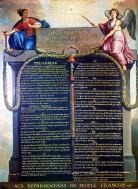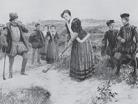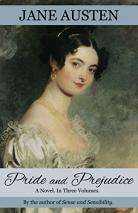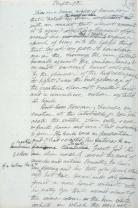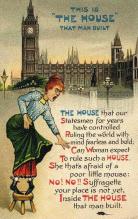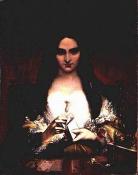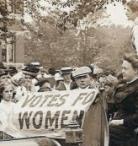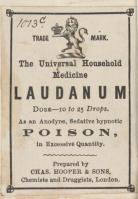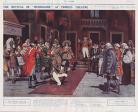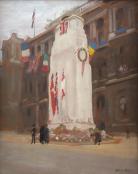Plotting the Supernatural
Created by Heather Witcher on Mon, 03/07/2022 - 11:58
Part of Group:
This timeline will offer touchpoints for the publications of the supernatural texts we're reading this semester and the historical/cultural events that encouraged creative artists to respond with poetry or prose.
Timeline
Chronological table
| Date | Event | Created by | Associated Places | |
|---|---|---|---|---|
| 1773 |
Aiken, "On the Pleasure Derived from Objects of Terror"John Aiken and Anna Letitia Aiken (Barbauld) published their essay in 1776. The essay establishes the connections between the sublime and the supernatural, which offered inspiration to later writers of supernatural poetry and fiction. |
Heather Witcher | ||
| 1780 to The start of the month Jan 1818 |
Galvanism in Mary Shelley's FrankensteinMary Shelley published the first volume of Frankenstein on January 1st of 1818. One of the elements of the inspiration for Frankenstein was the scientific discovery of galvanism. This is the act of generating an electric current through an organism to create muscle activity. Scientists used this method on the dead corpses of animals in the late 1700s. For example, this type of experimentation was used on Mary Shelley's former pet dog. Then in 1803, the dead body of a criminal was used for an exhibition of this method for the public. |
Jonah Maynard | ||
| May 1789 to Nov 1799 |
The French Revolution in Mary Shelley's FrankensteinThe French Revolution was a battle that lasted about ten years. This war resulted in the destruction of the monarchy as well as the French Consulate. The three main goals of the French Revolution was to achieve liberty, equality, and fraternity. In Frankenstein, the French Revolution had just ended, and Victor had created his monster during a time that people were still fighting and killing each other as though the revolution's ideals meant absolutely nothing. The creature reflected this behavior, but eventually learned what those ideals really meant and sought them out. |
Jonah Maynard | ||
| The end of the month Autumn 1789 |
Revolution and Gender InequalitiesOn August 26, 1789 the government passed soemthing called the "The Declaration of the Right of a Man and of the Citizen" The did not let women get equal political rights as of a man, but it gave women a way of civil equality. Women could divorce a man if she wanted to and many other good and beneficial ways. This could reflect on how women were view during the 1800s because it strived them and push to making more changes. In which they are brave for that. |
Edward Jr | ||
| 1798 |
Samuel Taylor Coleridge, "Rime of the Ancient Mariner"Coleridge publishes "Rime" in 1798 in the first edition of Lyrical Ballads. The poem was written between 1797-1798. It was revised and republished in 1800, 1802, and 1805 in subsequent editions of Lyrical Ballads. It was revised to add marginal glosses and republished in Coleridge's volume Sybiline Leaves in 1817. The last version of the poem appears in the same year as Coleridge's death: 1834. |
Heather Witcher | ||
| The start of the month Spring 1800 |
Romanticism MovementThe Romanticism movement (1800-1850) was developed in result of the French revolution. The industrial movement was beginning to take off and this made many feel as they needed to take a step back on life's new changes. It focuses on many things such as nature, imagination, the individual, and emotions over reality. In many new writings people would use these things to highlight there feelings towards what is happening around them. They would include nature in their art to show emphasis of how beautiful nature is and how the new buildings and "fast life" are not admiring to all. They would include supernatural aspects to there work to show question of their religion because science was providing new material to the world that raised questions of uncertainty. All of these ways made a new outlook for writings. One outlook that provided minor leadway was how women were strarting to be used in material as possessing a supernatural power but the downside is it was only a illusion of power. This was to show a womans status at this time. They had no real power and this bleeds into there writings. |
erica strickland | ||
| The start of the month Winter 1811 |
First Women's Golf Tournament 1811Scotland held its very first women's golf tournament in 1811. This events first began to form when Mary Queen of Scots (1542-1567) enjoyed golfing, she even had a golf course built during her reign. Women were not yet allowed to participate unitl the year 1811. The tournament was of a small town of fishermen and their wives. Even after this event challenges for women to golf were strained. They did not recieve the same treatment as men and they had little funding. In some areas the idea was just plain refused but this did not end hope for women here. This events would lead to the first women's golf club formed in1867. |
erica strickland | ||
| The end of the month Winter 1813 |
Pride and Prejudice 1813Pride and Prejuice is a novel written by Jane Austen in 1813. The novel is based on a female's purpose during the 19th century in England. Jane Austen spent many of her years focusing on her education while other girls married young. This played a strong role on Jane's book because her only proposal had financial stability but she lacked any emotion towards the man. This left her in a difficult place for women during this time because the pressure to marry for financial reason was prominent. Women could not hold any true independence without a man and this is what she decided to base her book novel on. She wanted to pull attention towards the forceful nature of women having to marry for other reasons than love alone. This period piece was written during the Romanticism movement which she emphased on emotions over what choices she should make. She wanted the world to see the insight of how it feels from a female's perspective on having to marry to be secure. The way Jane wrote her work was to impact on how women were viewed during this time. She wanted to help them see marriage should be more than what is expected of women but rather draw the focus to love as the main reason for marriage.
|
erica strickland | ||
| 1818 |
Shelley, FrankensteinDuring the Genevan summer of 1816, Mary Shelley conceived of Frankenstein and began writing it as part of a competition with her husband Percy Shelley, Lord Byron, and Byron's physician Polidori. The novel was published anonymously in 1818. The second edition, published in 1820, bore her name. |
Heather Witcher | ||
| 1819 |
Keats, "La Belle Dame Sans Merci"Keats published his ballad in 1819 and revised it in 1820. The poem takes its inspiration from the 15th century and turns to the medieval past in pursuit of depicting the femme fatale. |
Heather Witcher | ||
| Autumn 1819 |
John Keats Engagement To FannyJohn Keats was very in love with this lady named Fanny Brawne. In 1819 he ends up getting engaged with her and gives her this beautiful engagement ring. Later, he finds out that he as tuberculosis and that he was not going to be able to live very much longer to be with Fanny which is why he wrote the poem "La Belle Dame Sans Merci". |
Edward Jr | ||
| 1824 |
Landon, "The Charmed Cup"Letitia Elizabeth Landon published "The Charmed Cup" in her 1824 volume The Improvisatrice and Other Poems, with Embellishments. |
Heather Witcher | ||
| 1826 |
Ann Radcliffe, "On the Supernatural in Poetry"Radcliffe publishes her essay in 1826 in New Monthly Magazine (volume 16, number 1). The essay is known for its distinction between terror and horror, and the role of the imagination for the supernatural. |
Heather Witcher | ||
| 1830 to 1929 |
Womens Suffrage movement in EnglandThe womens sufferage movement gained attention in the 1830s and 40s but really began to take off in the 1860s. Similar to the one that occured in America this movement was attempting to gain women the right to vote in england. This movement didn't earn women the right to vote until almost 1930, but the women were motivated and pushed foward the entire way. This event was a huge step for women. This started to show how women could work together to over power the things that men wanted. This would lead to women overcoming one of the biggest legal issues and would finally gain them representation in politics and the decisions made in society. |
Codey Brockman | ||
| 4 Sep 1839 to 29 Aug 1842 |
First Opium WarThe First Opium War was a series of battles between Britain and the Qing dynasty of China. The war began between the two countries because of China's goal to obtain opium stocks in hopes to permitt the banned opium trades with Britain at Canton. In addition, The Chinese government were also threatening the death penalty to offenders. The British government did not agree with China's plans. The British government believed in the system of free trade and supported the opium trades in Canton. Britain's Royal Navy defeated the Chinese and the Qing dynasty signed the Treaty of Nanking. This treaty granted Britain indemnity and extraterritoriality to British in China, opened five ports to British merchants, and gave Hong Kong Island to the British Empire. This event is signicant to the text (Goblin Market) because it shows Britains support for Opium during the Victorian Era. This contradicts Rossetti's view that Opium addiction is a problem during this era.
|
makynde nunn | ||
| 1848 |
D.G. Rossetti, "The Card-Dealer"Rossetti writes the poem "The Card-Dealer" in 1848, but the poem is not published until 1870 in Rossetti's Poems. |
Heather Witcher | ||
| The middle of the month Summer 1848 to The middle of the month Summer 1848 |
Seneca Falls ConventionThe Seneca Falls Convention on July 19, 1848 was a convention that held a way women to come together and discuss the rights of women. That movement also started a women suffrage movement. This story could reflect to how the society viewed women in the literature and artistic pieces as describing them as bold and also persuasive is well. This can also reflect to the poem La Belle Dame Sans Merci on how women are very persuasive. |
Edward Jr | ||
| 1850 |
D.G. Rossetti, "The Blessed Damozel"Dante Gabriel Rossetti published "The Blessed Damozel" in 1850 in The Germ. He revised the poem multiple times and published differing editions in 1856, 1870, and 1873. In 1871, Rossetti accepted a commission by William Graham to illustrate the poem with his painting of the same name. The painting was completed in 1878. |
Heather Witcher | ||
| The end of the month Autumn 1850 |
First National Womens Rights ConventionIn 1850 around the number of 900 people mainly women but some men attended this convention to hear problems surrounding womens sufferage as well as other social issues. This convention would also touch bases on civil rights issues during the time aswell. At the convention they would disscuss topics such as wages, education, career opertunities, and marriage. The convention would later become a annual meeting where women would discuss these topics to further inform others on the things they deserved. This event is signifigant because it was not only one of the first womens conventions but it was the first national womens convention that discussed the rights the women deserved. Conventions like these changed the view that not only women had about themselves but also the way some men felt about women. Once the women had a different perspective on the way they should be treated they gained the confidence to push foward with making change for the future. It could be argued that the knowledge the women gained from these conventions is what led to where we are today with rights of women. |
Codey Brockman | ||
| 8 Oct 1856 to 24 Oct 1860 |
Second Opium WarThe Second Opium War was fought between the British and French Empires against the Qing Dynasty of China. The cause of this war was due to Britain being unsatisfied by the way Treaty of Nanking in regards to the goals of improved trade and diplomatic relations. The result of this war was the second defeat of the Qing Dynasty which led China to sign peace two peace treaties with Russia; Tianjin Treaty and Beijing Treaty. This event correlates to the text (Goblin Market) the text is published during post-war Britain. Opium was a major factor in the corruption of Britain's society. |
makynde nunn | ||
| 1859 to 1870 |
Christina Rossetti's time at Highgate PenitentiaryDuring the time of 1859-1870 Christina Rossetti spent time working at the Highgate Penitentiary. Here she did nun-like work and acted as a type of big sister to the women that resided in the penitentiary. Highgate was a place that focused on the reformation of fallen women through repent and prayer. When refering to "fallen women" we are discussing prostitutes or women who had sex outside of their marriage. While working here Rossetti was able to see the effects that the patriarchial power men had. She was able to have her eyes opened and gain a better understanding as to how these women became "fallen women" and how society felt about them. Because most of the workers were women Rossetti was also able to see the damage that women could have even on each other. Instead of truley understanding why the fallen women happened they just focused on trying to fix them. |
Codey Brockman | ||
| 1862 |
Christina Rossetti, "Goblin Market"Christina Rossetti began composing her poem in 1859, and it was published in her first volume of poetry: Goblin Market, and Other Poems (1862). The volume includes two illustrations of key scenes by Dante Gabriel Rossetti. |
Heather Witcher | ||
| 31 Jul 1868 to 31 Jul 1868 |
Pharmacy Act of 1868The Pharmacy Act of 1868 was one of the first attempts to limit the sale of poisons and dangerous drugs, such as opium, cocaine, and laudanum. Before the passing of this Act, consumers could walk into a chemist shop and freely purchase recreational drugs without a prescription. This relates to the text (Goblin Market) because drug usage was a concern for Rossetti in her time at the Highgate Penitentiary due to the amount of women who were dealing with addiction. This is a result that the cries to bring awareness to drug addiction were being heard. |
makynde nunn | ||
| 1882 |
Oscar Wilde's American TourOscar Wilde being one of the faces of the aesthetic movement wanted to travel to America to both promote the aesthetic idea (art for arts sake) and also spread European literature to America. He introduced European authors that many had not heard before, gave lectures on literary movements, shared texts, and overall attempted to educate Americans and spread ideas. While Wilde had done what he set out to accomplish, he found America as distasteful, uncultured, and overall Americans lacked the same sort of class he saw Europeans possessed. The story of "The Canterville Ghost" is inspired by this tour. The story demonstrates a clear contrast between the American family and the Europeans in the story, the American family having no care for history and only caring about materialistic things like Wilde expressed in his reports of his tour. Overall the story uses general stereotypes to push Wildes's perception of Americans. The photo I included is a clipping of the announcement of Oscar Wildes visit to America. |
Riley Gola | ||
| 22 Jan 1887 |
Ruddigore (The Witches Curse)Ruddigore or The Witches Curse is an opera by Arthur Sulivan and W.S Gilbert. The opera itself is revolving around a woman under a family curse to do bad deeds or else she'd be killed, and has tones about generational hauntings which one deals with that drives the story. This opera being released about a month prior to "The Canterville Ghost," shows us that this fear of a sort of haunting from the past or from a sort of inheritance (the woman being haunted from a bloodline, the Otis family in Canterville being haunted by a house) was previlant during that time, and many people recognized it and were able to deliver this perception in different forms. I think this also shows us historical themes that Wilde often wished to focus on both in "The Canterville Ghost," and also throughout his explanation for his disliking of America. Here I've included a drawing of a scene from Ruddigore, being from the ghost scene where the ancestors step out from their portraits to accuse someone of failing to carry out the requirements of the curse. |
Riley Gola | ||
| 23 Feb 1887 to 2 Mar 1887 |
Wilde, "The Canterville Ghost"Wilde published "The Canterville Ghost" in two parts in The Court and Society Review. The story was written after his American tour. |
Heather Witcher | ||
| 23 Mar 1887 |
"The American Invasion" Publication"The American Invasion," was an essay published to The Court and Society Review anonymously but is assumed to be from Oscar Wilde given the time period it was published, and the events he included in the essay. The essay itself includes his general impressions of the country, how he viewed the big cities and the people themselves. Overall the essays makes America out to be fairly boring, filled with failing attempts to seem lively or luxurious but ultimately flat and lacking substance. This essay is important in reference to "The Canterville Ghost," as it was published a few weeks prior possibly to get consumers thinking about these ideas prior to reading the story, or helping set the story up for its overall context of America being a lackluster recreation of Europe (he even describes the women as dressing similar to that in Paris, but not the matching attitude). The essay also enlightens us on Wildes's view of the country, which explains why he chooses to portray characters the way he does and the dynamics of the story (the American family being materialistic and the European characters/ the ghost being rooted in the history and culture). The photo I've included is a photo of Oscar Wilde himself, one of a series of portraits taken of him during his stay in America. The photographer, Napoleon Sarony, thought he was a great subject matter to photograph and took the majority of his portraits.
|
Riley Gola | ||
| 1890 |
Lee, HauntingsVernon Lee published her volume of supernatural tales in 1890. The volume includes an important preface that outlines the signficiance of the past and psychological interrogation. |
Heather Witcher | ||
| 1915 to 1919 |
Mew, "May, 1915" and "The Cenotaph"Mew wrote "May, 1915" as a response to the beginning of World War I, a war that was initially thought to end by Christmas 1914. "The Cenotaph" was written in 1919 for the first anniversary of the Armistice--the first Remembrance Day. |
Heather Witcher | ||
| 1917 |
Owen, "Anthem for Doomed Youth" and "Dulce et Decorum Est"Written while Owen was recovering from shell shock at Craiglockhart War Hospital in Edinburgh, the poems were published posthumously. Owen was killed in action on November 4, 1918. |
Heather Witcher | ||
| 1999 |
Carol Ann Duffey, Mrs. LazarusDuffey wrote this poem, Mrs. Lazarus, with the inspiration of the story of Jesus resurrecting Lazarus in the Bible. The poem was published in a collection of poems she entitled The World's Wife. This poem is written from the point-of-view of Lazarus' wife before Jesus came to bring him back to life. The importance of this poem is to express the dread of greiving for the death of a loved one as well as describe the patriarchy within Christian society. Near the end of the poem, Duffey reveals that raising Lazarus from the dead did not have the reaction that was expected. Instead, this only made her feel worse inside because for a brief period of time, she was grieving, but still capable of making a new life for herself. |
Jonah Maynard | ||
| 2009 |
Sarah Waters, The Little StrangerWaters publishes The Little Stranger in 2009. It is a gothic novel that is set in the 1940s in a ruined mansion in Warwickshire, England and describes the aftermath of living post-WWII. |
Heather Witcher |




